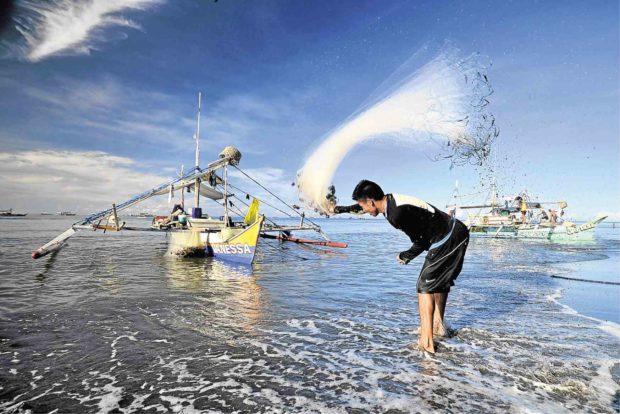
A fisherman cleans the net he used in Sarangani Bay, one of the country’s richest fishing grounds. —ARJOY M. CENIZA
DAVAO CITY—The five-province Autonomous Region in Muslim Mindanao (ARMM) emerged anew as the country’s top fisheries producer among 17 regions, providing nearly 26 percent of the country’s total fisheries output, data from the Philippine Statistics Authority (PSA) showed.
In its first quarter fisheries survey, the PSA reported that the region produced a total of 258,981 metric tons of fish and sea harvests.
The national fisheries output was more than 1 million MT for the first quarter of 2018.
Fisheries production is defined as hunting or producing fish and other marines species. It includes fish breeding and other aquaculture activities.
ARMM improvement
The PSA said ARMM’s first quarter fisheries production was higher than last year’s yield of 243,000 MT.
The region’s provinces host large bodies of water.
Maguindanao has Liguasan Marsh, Illana Bay and Moro Gulf in addition to Lake Buluan, where massive aquaculture activities were ongoing.
Sulu, Basilan and Tawi-Tawi shared the vast Sulu Sea and Celebes Sea.
The Zamboanga Peninsula was the second top producer but it provided only about half of ARMM’s output—129,792 MT.
The Cordillera Administrative Region, a largely landlocked area, contributed 1.3 million MT.
The PSA said while the ARMM’s fisheries production rose, the total national output actually went down by a little over 3 percent.
Commercial fishing
Commercial fishing output alone decreased by 3.39 percent to 216,000 MT compared to production last year.
Harvest of round scad fell by more than 14 percent, yellowfin tuna fell by more than 11 percent, milkfish fell by more than 7 percent and tilapia harvest fell by more than 5 percent, the PSA said.
Harvest of seaweed fell by a little less than 1 percent, it added.
Climate was mainly the reason for the production decline, the PSA said.
Delays in stocking fish pens in Laguna Bay due to restrictions imposed by authorities also caused a less than 1-percent decline in production, the PSA said. —ALLAN NAWAL